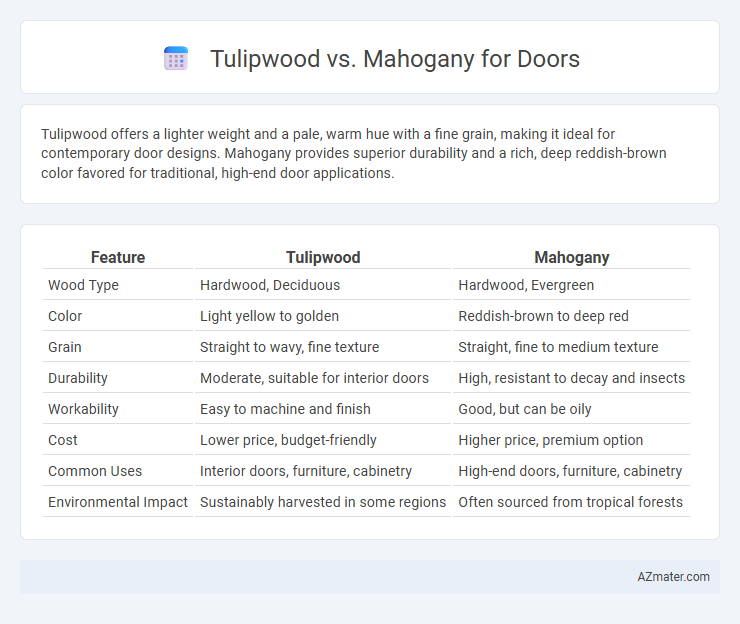Tulipwood offers a lighter weight and a pale, warm hue with a fine grain, making it ideal for contemporary door designs. Mahogany provides superior durability and a rich, deep reddish-brown color favored for traditional, high-end door applications.
Table of Comparison
| Feature | Tulipwood | Mahogany |
|---|---|---|
| Wood Type | Hardwood, Deciduous | Hardwood, Evergreen |
| Color | Light yellow to golden | Reddish-brown to deep red |
| Grain | Straight to wavy, fine texture | Straight, fine to medium texture |
| Durability | Moderate, suitable for interior doors | High, resistant to decay and insects |
| Workability | Easy to machine and finish | Good, but can be oily |
| Cost | Lower price, budget-friendly | Higher price, premium option |
| Common Uses | Interior doors, furniture, cabinetry | High-end doors, furniture, cabinetry |
| Environmental Impact | Sustainably harvested in some regions | Often sourced from tropical forests |
Introduction to Tulipwood and Mahogany Doors
Tulipwood doors are known for their smooth grain and light, creamy color that lends a modern and clean aesthetic to interiors, making them popular for contemporary door designs. Mahogany doors, highly valued for their rich reddish-brown hue and exceptional durability, offer a classic, luxurious appeal suited for both traditional and high-end settings. Both woods provide excellent stability and resistance to warping, but mahogany typically outperforms tulipwood in terms of hardness and natural resistance to rot.
Origins and Botanical Sources
Tulipwood, derived primarily from the Liriodendron tulipifera tree native to eastern North America, is known for its light yellow to orange hues and fine grain, making it a popular choice for decorative doors. Mahogany originates from species within the Swietenia genus, predominantly found in Central and South America, and is prized for its rich reddish-brown color and durability in door construction. Both woods offer distinct botanical characteristics that influence their aesthetic appeal and functional use in high-quality door applications.
Appearance and Grain Patterns
Tulipwood features a light, creamy-yellow hue with subtle orange or pink undertones, showcasing a straight grain that often has a fine, uniform texture ideal for doors emphasizing brightness and modern aesthetics. Mahogany displays a richer, deeper reddish-brown color with a natural luster, characterized by a more pronounced interlocking grain pattern that adds depth and elegance, perfect for traditional and luxurious door designs. The contrasting grain structures and color palettes of tulipwood and mahogany significantly influence the visual impact and style preferences for door applications.
Durability and Strength Comparison
Tulipwood offers moderate durability and strength, suitable for interior doors but less resistant to heavy impacts and weather exposure compared to mahogany. Mahogany is a premium hardwood known for its exceptional durability, natural resistance to rot, insects, and warping, making it ideal for both interior and exterior doors. Its dense grain structure provides superior strength and long-term stability, outperforming tulipwood in high-traffic or exposed environments.
Workability and Ease of Fabrication
Tulipwood offers excellent workability due to its lightweight and consistent grain, making it easy to machine, cut, and shape for door fabrication. Mahogany, known for its fine grain and stability, provides smooth sanding and is resistant to warping, though it is denser and may require more effort during cutting and joining. Both woods are favored by carpenters, but tulipwood is preferred for quicker, more efficient production, while mahogany is chosen for its durability and refined finish.
Resistance to Pests and Decay
Tulipwood exhibits moderate resistance to pests and decay, making it suitable for interior doors but less ideal for exterior use without proper treatment. Mahogany is renowned for its exceptional natural resistance to termites, fungi, and rot, offering superior durability for exterior doors. Choosing mahogany ensures enhanced longevity and reduced maintenance in environments prone to moisture and insect activity.
Cost and Availability
Tulipwood is generally more affordable than mahogany, making it a cost-effective choice for door construction without compromising on durability. Mahogany is prized for its rich color and fine grain but commands a higher price due to its scarcity and slower growth rate, often resulting in limited availability. Tulipwood is more readily available in North America, providing easier access for builders, whereas authentic mahogany, often imported, may face supply constraints and longer lead times.
Environmental Sustainability and Sourcing
Tulipwood offers a more environmentally sustainable option for doors due to its faster growth rates and lower impact on deforestation compared to mahogany, which is often harvested from slow-growing tropical rainforests facing illegal logging pressures. Sourcing tulipwood typically involves managed plantations and responsible forestry practices, whereas mahogany's high demand has led to stricter regulations and certifications like CITES to prevent overexploitation. Choosing tulipwood reduces carbon footprint and supports sustainable forest management, making it an eco-friendlier choice for door materials.
Ideal Applications for Each Wood Type
Tulipwood offers a lightweight yet durable option ideal for interior doors and decorative paneling due to its fine grain and ease of finishing. Mahogany provides exceptional durability and resistance to moisture, making it perfect for exterior doors and high-traffic areas requiring long-lasting performance. Choosing between tulipwood and mahogany depends on the door's exposure to environmental elements and desired aesthetic appeal.
Final Verdict: Choosing Between Tulipwood and Mahogany
Tulipwood offers a lighter, more affordable option with moderate durability, making it suitable for interior doors where budget and ease of customization matter. Mahogany, prized for its rich color, superior strength, and natural resistance to decay, remains the preferred choice for exterior doors or high-end installations demanding longevity and elegance. For door projects prioritizing luxury and weather resistance, mahogany is the final verdict, while tulipwood suits cost-effective, stylish interiors.

Infographic: Tulipwood vs Mahogany for Door
 azmater.com
azmater.com